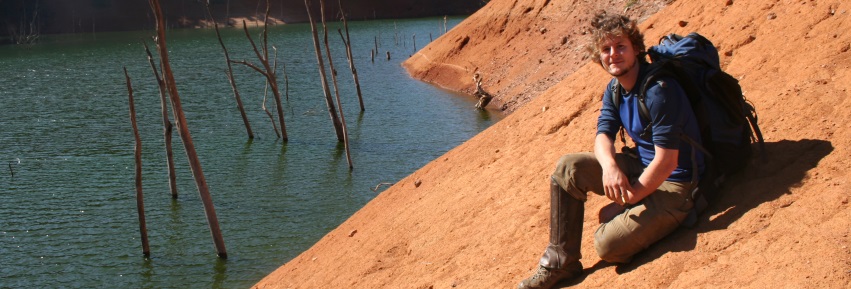Sam Robinson experiences Brazilian wildlife and night life while researching the restoration of degraded forest in one of the world’s biodiversity hotspots for his masters dissertation.
So there I was, packing up my things and cramming the last of the 75 soil samples into my suitcase to take back to the labs at Lancaster University, and reflecting on the experiences I’d had during the last two months I’d spent in Brazil.
Those early days in the vibrant and colourful city of Lavras already seemed like a lifetime ago. Since then I felt like I’d become a proper member of the research community in the Ecology department of Universidade Federal de Lavras – the Lancaster Environment Centre’s partner university in Brazil, which hosted me while I collected data for my master’s dissertation.
It wasn’t hard to get swept up in the activity and life of Lavras – especially as I was instantly accepted into a large circle of friends (in very Brazilian fashion!). They initiated me straight away into the apparently constant events and celebrations, which seemed to be endless (particularly as the trip just so happened to coincide with the World Cup…). The work-hard, play-hard motto is definitely taken seriously here – which took some adjusting to!
But I wasn’t just in the hustle and bustle of the city. Almost half the time I spent traipsing around the wilderness in the neighbouring state of Rio de Janeiro with a couple of fellow Brazilian masters students, guided by my Brazilian supervisor – the (thankfully) tireless Dr Eduardo van den Berg.
The project – discovering pathways of regeneration
My dissertation, for my MSc in Ecology and Conservation, was an investigation into the factors affecting forest regeneration and the recuperation of ecosystem services (specifically the potential for carbon storage) after clearance of Brazilian Atlantic Forest. This tropical biome is a global biodiversity hotspot that has undergone extensive degradation over the last few hundred years."
Luckily for me the study site was located next to the stunning and extensive Itaiaia National Park, the oldest nature reserve in the country, on the border between São Paulo and Rio de Janeiro states. It is home to many exquisite (and freezing cold) waterfalls - which I had the pleasure of experiencing first-hand!
Soil and environmental conditions play a major role in the development of plant communities (which in turn influence the restoration of degraded soil) from initial grasses and shrubs to mature forest, in a process known as succession.
This study was designed to try to unpick the complex interactions involved in developing forest on abandoned pastureland around the vast Funil reservoir on the Paraíba do Sul river, Itatiaia. The aim was to provide context-specific knowledge of the underlying drivers of succession to aid management of this process.
This project formed part of a wider comparative analysis in the area, sponsored by the national Furnas-Aneel energy company, to provide a basis for future restoration programmes. The location of the reservoir, in a basin between the Serra da Mantiqueira and Serra do Mar mountain ranges, means there is potential to connect Itatiaia National Park and another reserve, the Serra da Bocaina to the south, by establishing a forest corridor.
Into the wilderness…
Well, that what it sounded like on paper. But all of my reading and plans couldn’t really prepare me for the reality – I’m not really sure I knew what I was getting myself into! I definitely won’t forget the long days of hiking across hillsides measuring trees, digging holes, dodging snakes and avoiding dangerous bugs and poisonous palms. I will always remember the particular hum you get under the dense forest canopy, and the quiet boat rides across the still waters of the vast reservoir, reflecting the lofty peaks and majestic mountains shrouded in the deep green of the Mata Atlântica.
An end to the expedition
It wasn’t easy to leave the place that I had come to call home in Lavras, the very good friends I’d made and the university family I’d become a part of (not to mention the food!). During the nine weeks I’d seen two huge cities (including a brief interlude at the Copacabana), town life, the rural countryside and the wilds of Brazil. I’d experienced the incredible diversity and beauty of the flora and fauna - not all the wildlife and plants were hostile, with birds and monkeys rife in the treetops, even within the grounds of the university itself.
But the prospect of finding out the secrets held in the pieces of earth I took back to the Lancaster Environment Centre labs was exciting. More of the story of the Atlantic Forest was yet to be told…
Secrets of the soil
After analysing my samples, the results suggest that forest recovery in this area may be limited by factors such as the competition between particular plant communities for available resources, and a lack of tree seed dispersal. My study also shows that vital ecosystem services, such as soil carbon storage, has the potential to improve quickly if these barriers are removed through specific management actions - like the seeding of certain adapted and native tree species, and the removal of dominating shrubs.
I can’t express my thanks enough to the particular staff at Lancaster Environment Centre and Universidade Federal de Lavras who organised the project, and of course Santander for their generous support in providing the scholarship to travel to and study in Brazil - without which it would not have been possible.
Read more about Sam’s time researching in Brazil on his own blogsite.
Find out more about studying an Ecology & Conservation MSc at Lancaster Environment Centre.
Disclaimer
The opinions expressed by our bloggers and those providing comments are personal, and may not necessarily reflect the opinions of Lancaster University. Responsibility for the accuracy of any of the information contained within blog posts belongs to the blogger.

